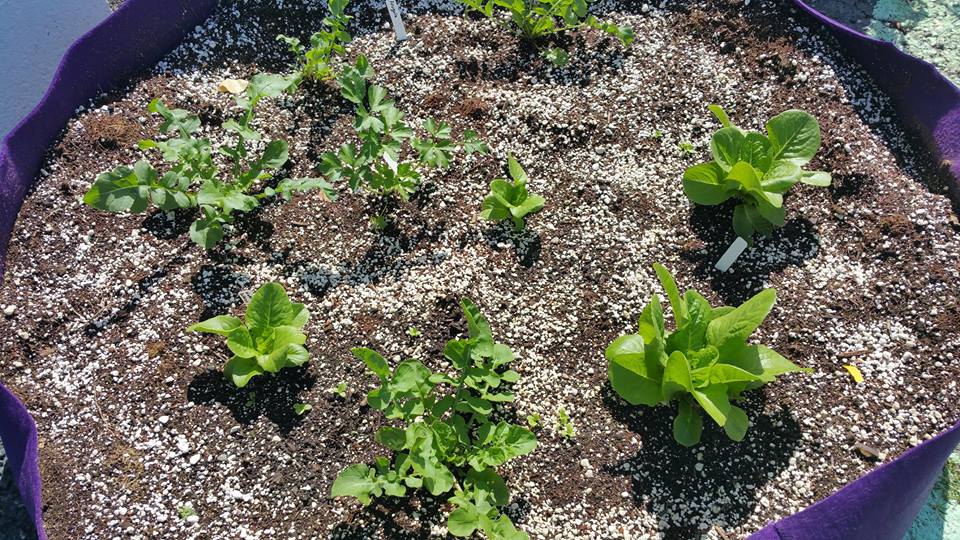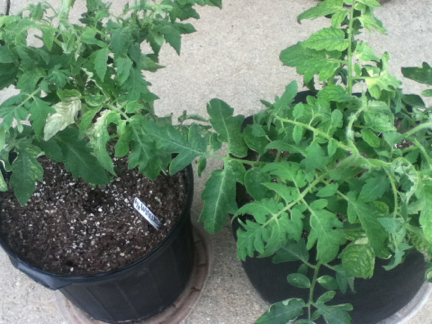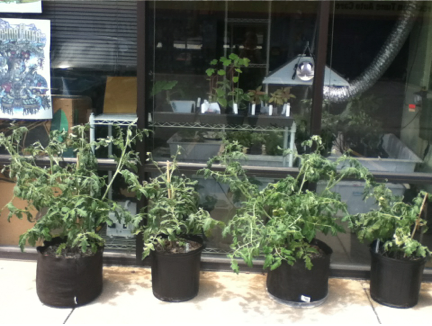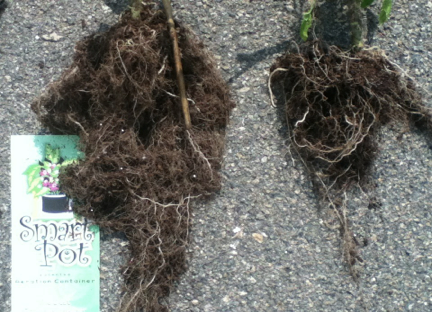 Humans have been cultivating plants in containers for thousands of years. Horticultural pottery fragments from Egyptian settlements date back to 10,000 years ago, and more recent Roman remains have shown that they were likely the first to grow perennials in containers for the purpose of bringing them indoors during colder weather. As gardeners in 2015, the only things that differentiates us is the technology.
Humans have been cultivating plants in containers for thousands of years. Horticultural pottery fragments from Egyptian settlements date back to 10,000 years ago, and more recent Roman remains have shown that they were likely the first to grow perennials in containers for the purpose of bringing them indoors during colder weather. As gardeners in 2015, the only things that differentiates us is the technology.
Unglazed terracotta containers were the OGs of container gardening – these porous pots are able to insulate the root zone from hot and cold temperatures as well as allow the root zones to “breathe” with the very small amount of air that is able to pass through the clay walls.
The downside of these pots is their price and weight. Plastic pots came along in the 1950s and, being less expensive to produce and much lighter and more durable, these pots quickly took over. Plastic pots are far from perfect, though.
When roots grow to the edge of a plastic pot, there is a small layer of water and nutrient between the medium and the walls. As roots’ sole purpose is to hunt out food and water, the plant is tricked into thinking there is still space for it to grow even while its wrapping around the edges inside your container. So what’s wrong with living on the fringe? Roots like cool and moist conditions and plastic pots can get fairly warm (especially under grow lights or in direct sun). The roots that are circling around the inside of the edge are more susceptible to excess heat (with no media for insulation), drought (the edges of growing media tend to dry out first), and disease (unhealthy roots suffering in these regions are more prone to disease).
Leave a plant in a plastic pot for too long and inevitably you get a few large roots wrapping and circling around the edges of the pot over and over and eventually choking itself out.
So how do we get the roots to concentrate their growth within the growing media? Enter air pruning!
Air pruning is a technique that exposes root tips to relatively dry air, thus stopping their growth. The plant now realizes its boundaries and focuses on creating secondary roots that branch out from the originals within the growing media. These secondary roots then spread throughout the media until they reach the thin layer of air at the walls, and the cycle is then repeated. Over and over your plant is producing smaller, more fibrous roots, filling up its container. More root hairs = more root tips, and more root tips = more water and nutrient uptake. In short, the overall effect of this growth and pruning cycle is the creation of a well-developed root system in a relatively short amount of time.
Benefits of Aeration Containers:
- Stronger, healthier plants and starts
- Less growing media needed*
- Improved overall root structure (more root tips)
- Decreased risk of transplant shock
- Better use of water and nutrients
- Promotes beneficial biology
- Quicker Growing times
- Elimination of root wrapping (circling) in pots
- Fewer transplants required
*Plants grown in root-pruning containers demonstrate the ability to cope with being containerized for longer — I personally love them for container fruit trees. This means you could potentially decrease the size of your container without the risk of a plant becoming root bound. Just note, you may have to water more frequently.
A few types of root pruning containers:
- Smart Pots – Made from custom black (or tan) non-woven polypropylene material. The black fabric helps warm growing media (outdoors in early season) and allows heat to escape via breathable material. These pots are highly durable (think 5+ years of continuous use) and many sizes come with handles!
- Root Pots– Made from 100% recycled materials (often jean fabric), they have a blue-ish recycled look to them. These also help with thermal insulation during cold temperatures and evaporative cooling during hot conditions. Root pots are biodegradable and reusable for 2.5 – 5 years.
- Air Pots – A black plastic container with an unusual design – inward and outward-pointing cones resemble egg carton. The bottom is a plastic mesh. These containers are highly durable and can be taken apart for storage.
- Winstrip Trays – 72 cell propagation trays with an open design that enables air pruning in the early stages of plant life. Highly durable polypropylene plastic is UV resistant and usable for 10-15 years. (https://fifthseasongardening.com/winstrip-trays-soil-blocks-without-the-mess)
Here are some photos from our experiments growing plants in plastic containers vs. Smart Pots.




Andy Harrison says
Oh wow, I didn’t know that there were different types of planting pots. I always thought that there were just “pots” and that was it. Anyways, it does seem important to get the right kind for the plant you have. Getting the right kind would promote better growth and would result in a stronger plant.
neelam says
That was informative.
Can I safely infer this is applicable to ceramic pots as well. they are also like plastic pots for root growth?
ashley says
Yes – same principle.
Gary says
I’m going to wrap the sides of my felt pots with plastic wrap. This should still leave good drainage and cause less watering to be needed.
Mike says
Can you use natural cotton bags?
ashley says
The fabric planters are made of a really thin yet strong fabric that lets air circulate well without getting too soggy. I’m worried that cotton might absorb a lot of water and not structurally hold up. You could certainly try it and see what happens!
Claire Lawing says
“Smart Pots – Made from custom black (or tan) non-woven polypropylene material. The black fabric helps warm growing media (outdoors in early season) and allows heat to escape via breathable material. These pots are highly durable (think 5+ years of continuous use) and many sizes come with handles!”
How do you know the pots are made from polypropylene? I’ve been searching and have found no answers specifying the plastic grade(s) that comprise the material.
Their website states (FAQ): “The Smart Pot is made of inert, porous, geo-textile fabric. As opposed to a few of our competitor containers, we are BPA-free, and have no significant amount of copper or lead. There is no meaningful chemical exchange with the surrounding environment.”
Thank you.
Amy says
So much information and such an exiting new way to garden. Now almost anyone can have something growing and that’s good for health and wellness.
I am using different variety pots, brands and sizes this year. Some things don’t grow well in the set up at my home. (Old concrete
trough from when this was a farm with water pouring off the roof above. No gutters). I’m growing a lot of medicinal plants and I’m glad to know about the composition of different bags.
To Dickie- that comment says a lot more about you than the person you’re referring to. Sad.
Oscar O'Malley says
I had no idea root pots are good for both insulation and evaporative cooling! Where I live there are hot summers and freezing winters. I’d hate for the plants in my backyard to suffer through the climate changes. Thanks for the tip on different containers for the plants, I’ll have to let my wife know so we can start taking more care to keep our plants around longer!
Rajendran says
Explanation on air pruning is interesting.
Shea says
I have a tomato garden in my backyard but these weeds totally destroyed my plant. Now I started a new veggie garden this year and while at my local nursery, I noticed a stack of plastic pots next to their dumpster. Great! now I have bunch of small plants and shrubs in my balcony as well in my garden.
Anyways many thanks for this informative post.
http://www.sijigreenhouse.com/products/planting-pots/natural/
Kay says
I have some vinyl material that I would like to use for making pots. Is this an example of non-woven polypropylene material?
ashley says
Hi Kay,
I’m not sure about vinyl – the important thing about using pots that will air-prune is that the pot material be breathable, so air can get to the roots as they grow to the edge of the pot.
Renee says
At the beginning of this article which is quit interesting, yours said you use this form of container for fruit trees. Can you give examples of what fruit trees you have planted in these pots.
I live a mountainous area so I have a lot of wild life that enjoy gardens. I have put everything I grow in pot and would like an apple tree etc in my garden. Would a draw one work in one of these pots
Frances says
Isn’t polypropylene a type of plastic? Is there a fabric that is natural that can be used?
ashley says
Hi Renee, Apple trees would not really work in containers. Some trees that would work in containers include fig trees and dwarf mulberries. Also citrus trees: lime, lemon, orange, grapefruit. But these trees would need to be taken inside when the weather gets chilly, FYI.
ashley says
Hi Frances, Root Pots are made from recycled fabric, cotton jeans, I believe. They will break down faster than the other fabric pots, but are not made of plastic.
Meach says
I have Goldern Dorset apple tree, a Mid pride and Ever pride peach tree, an elephant heart plum, Belguim Apricot and Asian Pear all in the geo bags and so far so good. They were uprooted out of the ground when I moved back in November. They all went dormant but came back strong and I do have fruit but not as many as I did when they were in the ground. Im in Arizona so they are all low chill hour trees. We will see how they do in the summer here. Ive been told they will do fine.
Tiffany says
When direct sowing seeds – is there a difference in timing between planting in the grow bags vs in-ground direct sowing? I can’t seem to find any information on this issue. Seed packets give you a direct sow date range – need to know if this still applies to the bags or should there be a delay since the bags may be more likely to get “cold” outside. Hope I am making sense. Thanks!
ashley says
For seeding, you can pretty much do them at the same time because the seeds and new roots are so shallow there won’t be much difference between temps in the fabric pots and the ground. With more mature plants, being able to root down and be surrounded by earth does make a difference. Plus, in the grow bags, if you get super crazy cold nights, you can temporarily bring your tender babies inside, or up against your house for added warmth!
CostumeLooks.com says
The breathable fabric allows oxygen to aerate the root zone from all sides, rather than from just the top. The oxygenation helps beneficial microbes in the soil thrive and contributes to a healthy rhizosphere (the living area around the roots), as the breathability and evaporative cooling helps keep temperatures low (conversely, temperatures in plastic pots reach such extreme levels that they could literally cook the microbiology in the soil). It s like wearing a wet t-shirt rather than a trash bag.
frank robbins says
What about the potential of root rot and mold using fabric pots?
CORDIE MOIR says
If I grew a dwarf mulberry in a smart pot, would it survive the winter in it, either sitting on my elevated deck or on the ground covered in snow, if I live in zone 6b, and the tree is hardy to zone 4/5?
ashley says
Good question. Hardiness zones are calculated based on plants being in-ground, where their roots are more protected. You can always wrap insulating row cover around the smart pot and plant to help protect it, while still allowing light and water to get through. If your plant is movable, you could move the dormant plant near your house where it will gain more protection as well.
Deb Prier says
I have deck planters made with Trex material (vinyl). Could I use the fabric bags and place inside the planters?
ashley says
Yes. we don’t see why not, as long as the Trex planter boxes have drainage holes, so that your fabric pots wouldn’t be sitting in water after a rain.
Darin says
If I am transplanting potted fruit trees from the store into air pots should I break up or loosen the root ball at all or place them in as is? I’ve been told to not break up the root ball if planting in the ground but am not sure if the same applies to air pots or if I should loosen them up a bit so they can grow out?
Ana says
I was curious if you ever considered changing the
structure of your website? Its very well written; I love what youve got to
say. But maybe you could a little more in the way of content so people could connect with it better.
Youve got an awful lot of text for only having one or two images.
Maybe you could space it out better?
Penny says
I just learned that uv rays break down polypropelene. Yet many fabric grow pots are made of polypropelene. So how do they last several years as described?
ashley says
Not sure what chemistry they use, but the Smart Pot fabric bed we have planted in our nursery has been in continuous use for at least 5 years now, and it looks almost new. Similarly, I’ve used fabric container each year for tomatoes and peppers, and they have held up year after year.
ashley says
We would recommend opening up the roots a bit when transplanting, especially if the tree has become root-bound in its original pot.
Franklin White says
I have never heard of air pruning before but I might try it because I want to get plastic pots for my plants. I want the roots to stay at a reasonable size. I’ll look up more techniques that relate to air pruning and see if I can buy everything I need from a local supplier.
Chris Pederson says
Cool I’m glad to see that smart pots are durable and have handles. I want to get into gardening. I don’t have time for individual pots though so I’ll get a machine to do it for me.
Adam Golightly says
I can understand how a business could really benefit from having the right equipment for them to be more efficient. Getting a potting machine from a professional to allow them to be more productive. It was interesting to learn about aeration containers can improve the root structure, biology, and growing times.
Doug Cauley says
Hi, thank you so much for your page. I know that the smart pots work great but, I wanted to ask how about for trees in either the smart or air pots? How they did short term and long term. If the roots grew out eventually or into the ground? Either thank you again so much! I hope to hear back from someone. God bless you all!
ashley says
For small patio citrus and berry bushes, these pots will work, but for larger fruit trees, we would recommend in-ground planting, both because of the long-lived nature of trees, and because they may need more of a root structure to avoid becoming top-heavy as they grow.